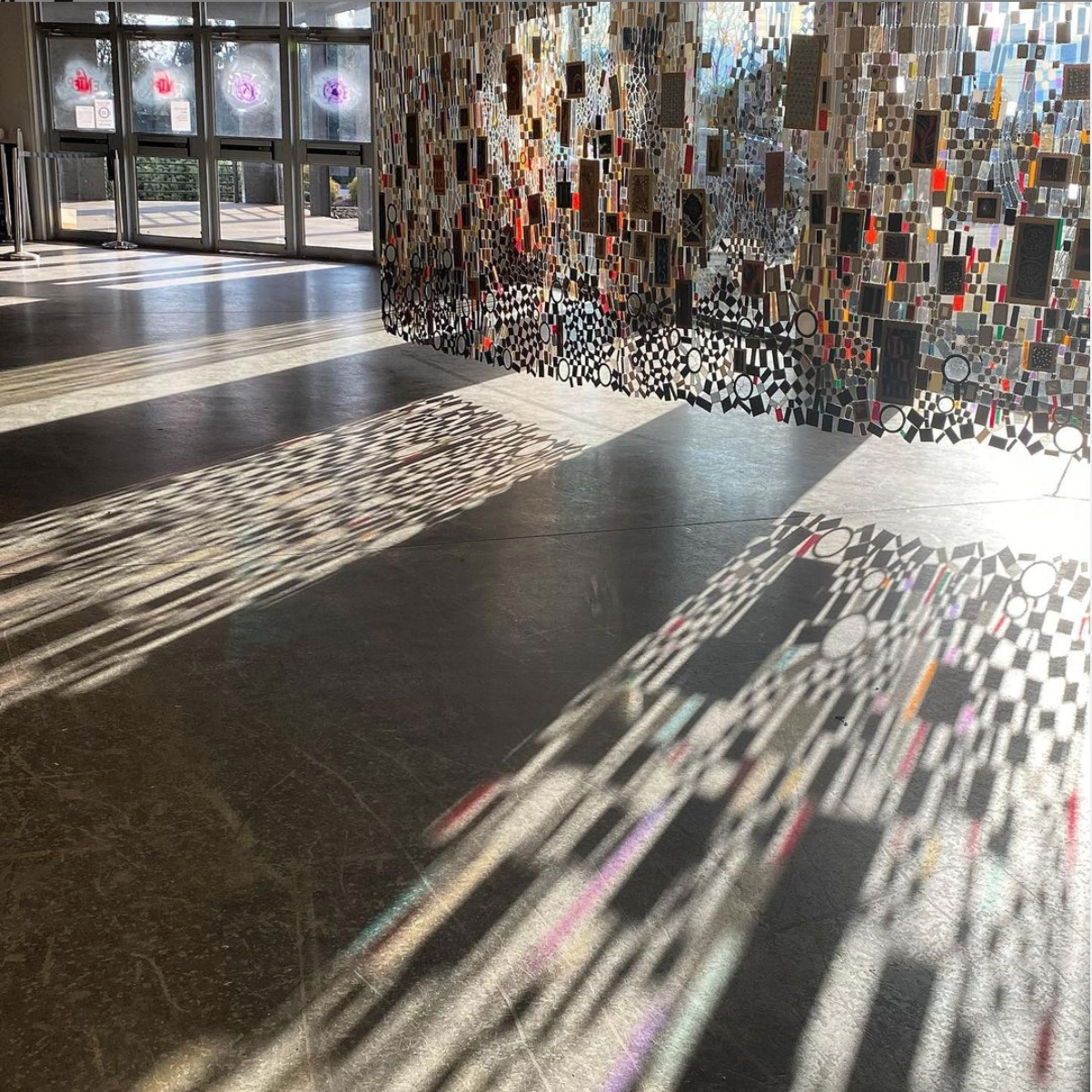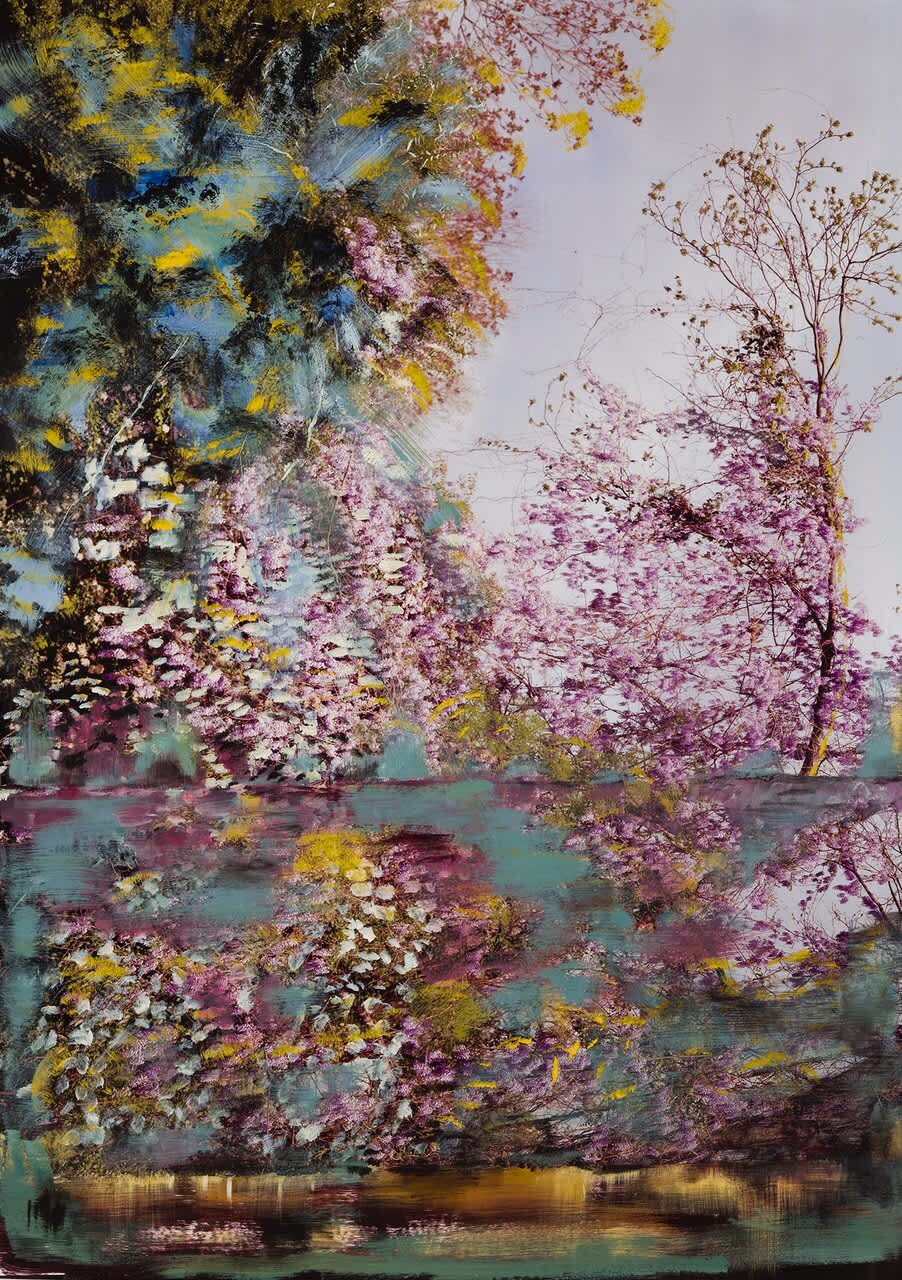“Fracture,” courtesy Amy Ashbaugh
When Amy Ashbaugh was a child, she and her brother spent the night with their two cousins. This was exciting because, at the cousins’ house, you were allowed to sleep with the radio on — an indulgence that wasn’t permitted at home. Despite the noise and excitement, sleep found the children. But in the night, when her brother and cousins slept soundly, Ashbaugh awoke. Her surroundings were at once strange and familiar, vaguely threatening but also comforting. Uncanny. Dream-like. Music played softly in the darkness. Anything could happen.
As an artist, Ashbaugh chases that feeling in her work — a sense of liminal space between dreams and reality. “I want my work to feel like that,” she says in a warm, animated voice. “Like it’s limitless, and you’re ok with that.” Her work feels like looking at a dream you had long ago. It is equal parts surreal and familiar.
The threshold between dreams and reality is a place in which we have spent plenty of time, this past year. “Surreal” seems the most appropriate word for a world in perpetual limbo, in which school, work, friends and family are accessible through screens. Stuck in our quarantine bubbles, the rest of the world feels impossibly distant.
“When you take people away from the things that are familiar to them, it’s surprisingly easy for people to lose track of themselves — their identity, the things that are important to them,” says Susan Clayton, a psychologist at the College of Wooster, in an interview for Wired.
Much Atlanta-based art from the past year wrestles with reality and identity in one way or another. Some artists, like Ashbaugh, explore imagination and isolation, while others wrestle with injustice and hope for a better tomorrow. The art coming out of this moment is “remarkable,” says Veronica Kessenich, executive director of Atlanta Contemporary. “It was cathartic, difficult. At the same time, it shows a sense of togetherness, unity, hope.”
Kessenich’s planning for the 2021 Atlanta Biennial shifted to reflect the state of the world as soon as doors closed last March. The two-part exhibition, titled Of Care and Destruction and Virtual Remains, deals intimately with issues of grief, loss, isolation, and resiliency. Contemporary art, Kessenich says, is obligated to confront the social issues of the day.
Image courtesy of @lillianblades
Lillian Blades’ “What is your reflection?,” one of the first installations as you enter Atlanta Contemporary, is an arresting, semi-transparent wall pieced together from shards of mirror and tinted glass, creating both beams of sunlight and patches of shadow. The piece intimates a fractured sense of self in a time of isolation and conflict. But it is also a challenge, encouraging the viewer to think about the light and shadows they cast on others.
Much of the art made in the last year is hyperlocal in subject, says Coco Conroy, gallery director at Jackson Fine Art, or is a revisitation of older work. Angela West’s Persephone, currently at Jackson Fine Art, reworks the artist’s archival photographs as large-scale painting-photograph hybrids. The layer of paint between viewer and photograph contributes a wild, joyful energy that renders spring fantastically bright.
“These Are Wild Thoughts,” courtesy Jackson Fine Art
In all its forms, artwork this year has been a way to engage with and process each iteration of the “new normal.” Kyle “BlackCatTips” Brooks, an Atlanta folk artist, dissected the idea of “normal” in a June interview with Georgia Public Broadcasting —
“Things seem normal here. And pretty. The bird calls are normal. The sky is blue like normal. The grass needs cutting like normal. But when I reach out to others or look at the news on my phone, or read anything, it’s all not normal. And I have a hard time with that. I’ve gone from being very concerned to now sometimes I don’t know if it’s all real or not.”
Visual art can be a powerful coping mechanism for anxieties and fears that we can’t see. Honor Bowman, the Chair of Fine Arts at Savannah College of Art and Design, says art has helped her stay grounded.* “The process of painting and making work has remained a constant — one thing I can control in my life.”
Others, like Ashbaugh, found creativity frustratingly absent in a world full of uncertainty. At first, when contracts fell through, shows canceled, galleries closed and the world shut down, she did, too. “I think it was about three months of anxiety stew,” says Ashbaugh. “For three months, I couldn’t work.”
As a freelance artist, Ashbaugh is used to feast and famine. She and her partner, Juan, supported themselves on one income for most of the past year. “I acknowledge that my position is pretty privileged,” she says. “It’s been a terrible time and that has not escaped me.”
All the same, Ashbaugh has been incredibly grateful for the time and clarity the pandemic afforded her. Gardening, cooking and staying in touch with a small pod of friends helped her re-center. Once she came to terms with not having anyone to tell her what to paint, Ashbaugh could create for herself. “I think what changed the most was my trust in myself and in my work and trying to find that state of play,” she says. “I’d been missing that for a very long time.”
Ashbaugh speaks in long, strung-along sentences with asides and addendums and asterisks that circle the “state of eternal possibility” she chases in her art. She looks for moments of magic in the everyday. Her art, at once familiar and impossibly fantastic, promises that “out of the ordinary things are part of the possibility of day-to-day existence.”
That promise is particularly enticing in a “new normal” that feels like the land of the Lotus-eaters or a twist on Groundhog Day. More than ever, we need to believe that anything can happen.
“Their Touch, Without Feeling,” courtesy Amy Ashbaugh
*Bowman’s opinions are her own and are not representative of Savannah College of Art and Design.
Originally published at The Comeback.




